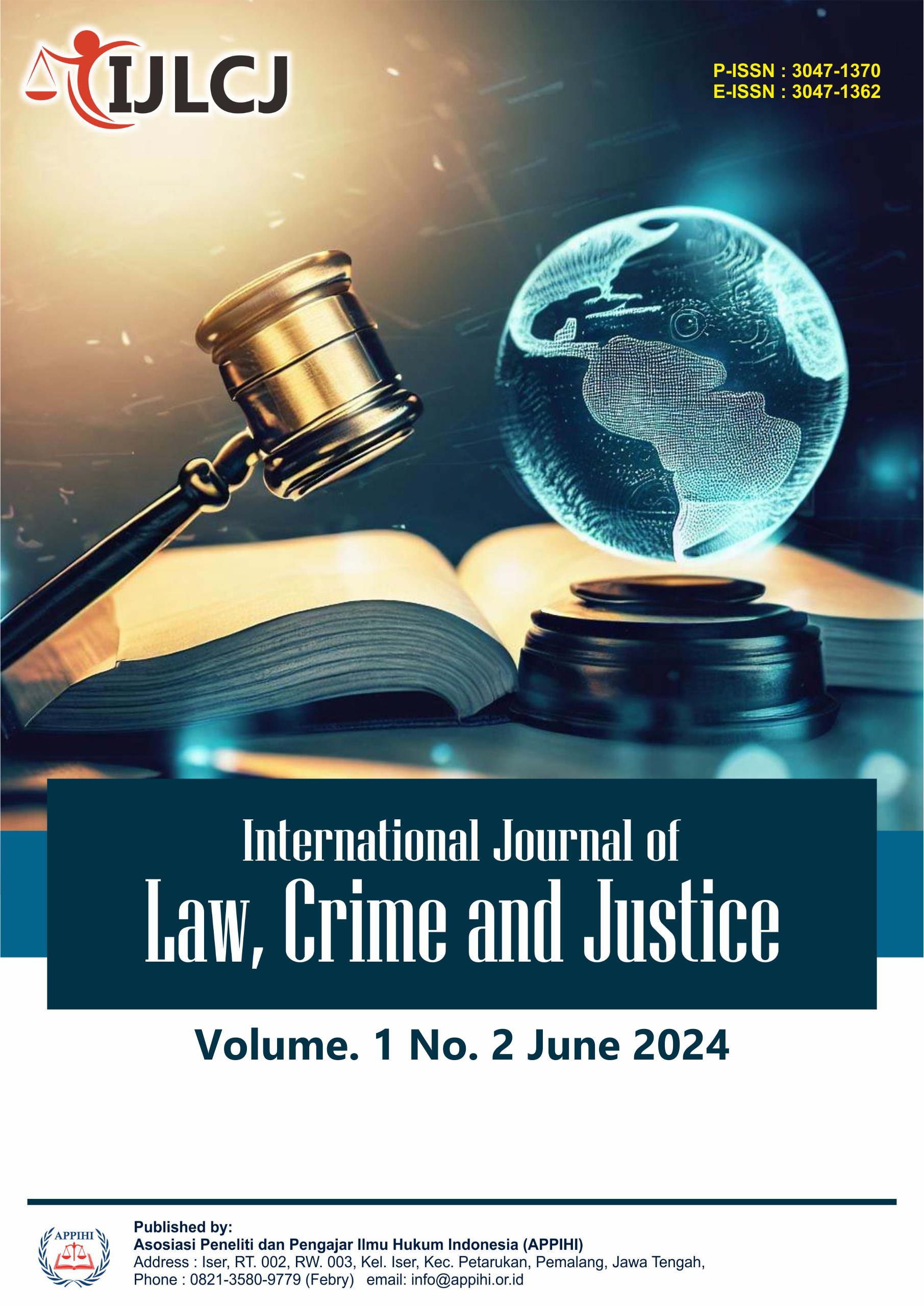International Maritime Law Strategy in Maritime Boundary Disputes Using Negotiation and Mediation
Analysis of Island Cases Sipadan and Ligitan
DOI:
https://doi.org/10.62951/ijlcj.v1i2.89Keywords:
International Law of the Sea, Maritime Boundary Disputes, Negotiation, and Mediation.Abstract
This article discusses the importance of reaching mutually beneficial solutions in international conflicts, focusing on negotiation and mediation as key elements. Negotiation allows both parties to resolve each other's differences, while mediation facilitates dialogue and promotes compromise. This research uses normative legal research methods with a statutory approach and case approach to analyze relevant laws and regulations related to the Indonesia-Malaysia maritime boundary, using the technique of collecting legal materials for literature studies. These disputes also impact social, political, economic, and environmental life, and both countries must accept the consequences of the Indonesia-Malaysia maritime dispute, such as dispute resolution costs, potential conflicts, and environmental impacts. The results of this study show that negotiations aim to achieve mutually beneficial solutions by providing a forum for communication, identifying common interests, constructive negotiations, and dialogue with regional, national, or international organizations such as the United Nations. Meanwhile, mediation plays an important role in reaching mutually beneficial solutions, assisting effective communication, information and education, claims actions, compromises, facilitating the negotiation process, and reaching mutual agreements.
Downloads
References
Dimas Fajri Nugroho. (2022). Disputes occurring in the South China Sea and their impact on international relations. International Treaty Law, (January), 1–6.
Dirha Kirana, ER, & Pratama Irsadanar, RJ (2022). Japan's strategy on managing territorial disputes of Senkaku Islands. Journal of Islamic World and Politics, 6(2), 207–227.https://doi.org/10.18196/jiwp.v6i2.16769
Dr. Hilman Syahrial Haq, SH., L. (2020). Community mediation as an alternative dispute resolution. In Lakeisha (Vol. 5).
Haerani, R. (2020). Juridical review of peace agreements in resolving disputes in court through a negotiation process. Unizar Law Review, 3(1), 72–73.
Hanifah, M. (2021). Comparison of the duties of mediators at the Indonesian Religious Courts and the Malaysian Syariah Courts. ADHAPER: Journal of Civil Procedure Law, 6(2), 101.https://doi.org/10.36913/jhaper.v6i2.134
Hidayat, D. (2022). Formalization of mediation as a civil dispute resolution mechanism. Journal of Literate Syntax, 7(8.5.2017), 2003–2005.
Kurnia, I. (2021). Maritime boundaries between Indonesia and Palau in the Exclusive Economic Zone. Estuary Journal of Social Sciences, Humanities and Arts, 5(2), 342.https://doi.org/10.24912/jmishumsen.v5i2.11456.2021
Kurniawati, FNK (2019). Maritime boundary dispute between Indonesia and Malaysia in the Ambalat region and resolution according to international law.
Marewa, YB, & Parinussa, E.M. (2020). Protection of Indonesia's outer islands based on the concept of an archipelagic state. Paulus Law Journal, 2(1), 1–14.https://doi.org/10.51342/plj.v2i1.151
Mayaut, CRAW, Anis, H., & Sinaga, TB (2021). International law study of dispute resolution over the Indonesia-Timor Leste border region. Lex Privatum, 9(3), 140–150. Retrieved fromhttps://ejournal.unsrat.ac.id/index.php/lexprivatum/article/view/33254
Munandar, A., Sudiarto, & Kurniawan. (2023). Option for resolving disputes outside of court. Citra Aditya Bakti, 8(1), 5.
Novianto, RD, Firmansyah, DA, & Pratama, NA (2020). Dispute resolution in the North Natuna Sea. Bonum Commune Business Law Journal, 3(1), 69–78.https://doi.org/10.30996/jhbbc.v3i1.3074
Nugraha, MF (2020). Challenges to Indonesia's maritime sovereignty in the Sulawesi Sea after the release of Sipadan and Ligitan Islands. Journal of Socio-Politics, 1(1), 14–25.https://doi.org/10.54144/jsp.v1i1.2
Nursalim, M., Puspoayu, E., & Hikmah, N. (2023). Settlement of disputes regarding Chinese vessels' fishing activities in the waters of the North Natuna Sea according to international maritime law. Novum: Law Journal, (1), 139–160.
Ramadhani, S., Kustiawan, W., Nasution, JH, & Azhari, MI (2022). Lobbying and negotiation strategies in the political communication process. An Nadwah, 28(1), 89–95.https://doi.org/10.37064/nadwah.v28i1.12255
Ramli, RP, & Lumumba Burhanuddin, P. (2021). Republic of Indonesia-People's Republic of China dispute in Natuna waters. Hasanuddin Journal of International Affairs, 1(1), 2774–7328.
Setiawati, N., Mangku, GS, & Yuliartini, NPR (2019). Settlement of island disputes from an international law perspective (case study of the dispute over Dokdo Island between Japan and South Korea). E-Journal of the Justisia Community, Ganesha Educational University, Department of Law, 2(3), 168–180.
Siregar, CN, Rahmansyah, S., & Saepudin, E. (2020). National security threats in Indonesia's border areas: Case study of Sebatik and Tawau Islands (Indonesia-Malaysia). Socioglobal: Journal of Sociological Thought and Research, 4(1), 26.https://doi.org/10.24198/jsg.v4i1.23933
Siti Mashawa Nanda Mirza, Khodijah Ismail, ADN (2020). Settlement of Indonesia's maritime problems with the South China Sea by means of negotiations.
Susetyorini, P. (2019). Indonesian maritime policy in the perspective of UNCLOS 1982. Legal Issues, 48(2), 164.https://doi.org/10.14710/mmh.48.2.2019.164-177
Triana, N. (2019). Alternative dispute resolution (alternative dispute resolution using mediation, arbitration, negotiation and conciliation models).
Turangan, V. F. (2021). Legal studies regarding the peaceful resolution of international disputes according to international law. 7(3), 6.
Ulhaq, ANZ (2022). Negotiation process in an effort to resolve the maritime boundary dispute between Indonesia and Malaysia. Papers, 1–12.
UNCLOS 1982 United Nations Convention Concerning the Law of the Sea (pp. 1–64). (1994).
Varykasha, I. (2019). Case concerning maritime delimitation in the Black Sea (Romania v. Ukraine). Investigation of positions. Lex Portus, 2019(5), 33–60.https://doi.org/10.26886/2524-101X.5.2019.3
Wahyudi, I., Risnain, M., & Pitaloka, D. (2023). Case study of the Permanent Court Arbitration (PCA) decision regarding the dispute over ownership of the South China Sea Exclusive Economic Zone (EEZ) between the People's Republic of China (PRC) and the Philippines. Mataram Journal of International Law, 1(1), 96–108. Retrieved fromhttps://journal.unram.ac.id/index.php/majil/index
Yanti, NLPMP (2022). Efforts to resolve the Natuna Islands conflict in the light of international law (the case of the dispute between Indonesia and China). 2(3), 79–95.
Hidayati, SN (2016). The influence of organizational leaders' hard and soft approaches on job satisfaction and the potential for employee strikes. Maximreneur Journal: Management, Cooperatives and Entrepreneurship, 5(2), 57-66.http://dx.doi.org/10.30588/SOSHUMDIK.v5i2.164
Risdwiyanto, A., & Kurniyati, Y. (2015). The marketing strategy for private universities in Sleman Regency, Yogyakarta, is based on marketing stimuli. Maximreneur Journal: Management, Cooperatives and Entrepreneurship, 5(1), 1-23.http://dx.doi.org/10.30588/SOSHUMDIK.v5i1.142
Bator, R. J., Bryan, A. D., & Schultz, P. W. (2011). Who gives a hoot?: Intercept surveys of litterers and disposers. Environment and Behavior, 43(3), 295–315.https://doi.org/10.1177/0013916509356884
Norshaheera, AW, Lailatul, FAH, Shahid, SAM, & Maon, SN (2016). The relationship between marketing mix and customer loyalty in
Downloads
Published
How to Cite
Issue
Section
License
Copyright (c) 2024 International Journal of Law, Crime and Justice

This work is licensed under a Creative Commons Attribution-ShareAlike 4.0 International License.





